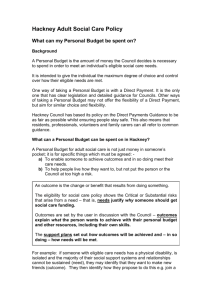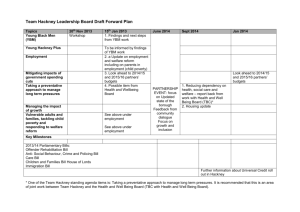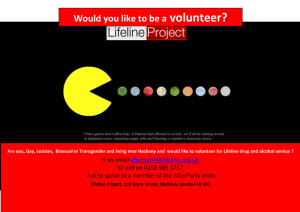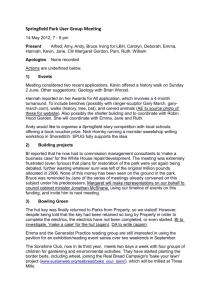Application Support Workshop 16/17
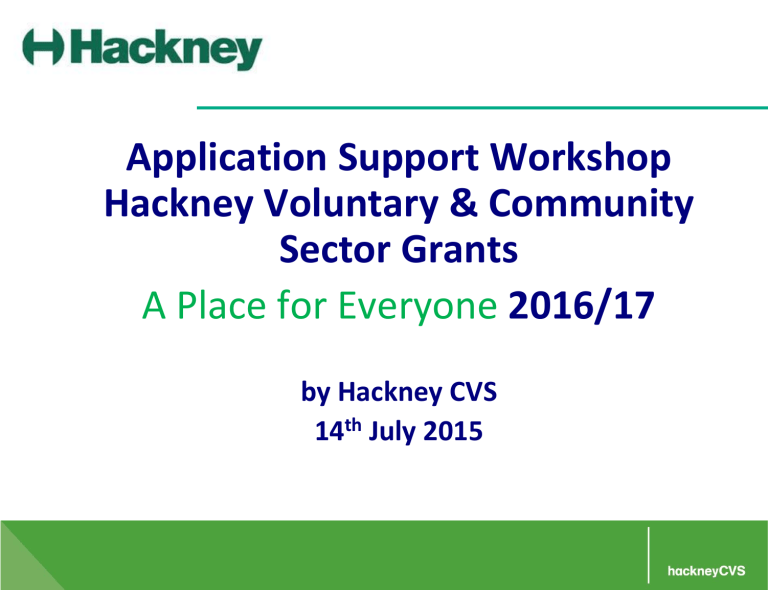
Application Support Workshop
Hackney Voluntary & Community
Sector Grants
A Place for Everyone 2016/17
by Hackney CVS
14 th July 2015
Overview of the Grants Programme
12:15- 13.00
Kishore Kanani
Hackney CVS
Senior Development Manager
Time
12:00 to 13:00
13:00 to 13:30
13:30 to 14:00
14:00 to 14:15
14:15 to 14:45
14:45 to 15:45
15:45 to 16:00
Todays Agenda
12.00- 16.00
Speaker
Overview of the grants programme - Kishore Kanani
Introduction to the evidence base – Helen Brock
Safeguarding – Kristine Wellington
BREAK
Understanding an Outcome Kristine Wellington
Preparing your Budget - Cyndi Smart
Feedback and closing - Kishore Kanani
House Keeping
Sign our sign in sheet
Mobile phones on silent
Fire alarm – Sainsbury’s Car park
Appreciate clearing cups from table
Toilets
Feedback form
Hackney CVS is Hackney’s leading voluntary and community sector support agency and local Council for Voluntary Service.
We support hundreds of people to run successful voluntary and community sector organisations by giving them access to the key skills, knowledge and resources necessary to respond to the needs of local people, especially those most in need.
Our Values Statement
As a responsive charity Hackney CVS believes that the voluntary and community sector plays a critical role in tackling poverty and disadvantage by working with key stakeholders to address local inequalities.
We strive to challenge oppression and prejudice, to promote diversity and to work towards a society where full equality for all is a reality.
Support and Advice
5.
6.
7.
3.
4.
1.
2.
How to Apply Workshops
One Stop Advice Surgery 16 September 2015
10 advisors one roof
Completed Application Review
Learn how to prepare a budget
Get a templates to Develop Project Idea
Write Safeguarding Policies for Adults and Children
Understanding Outcomes
Start with a Monitoring and Evaluation Framework
A place for Everyone Grants
2016/17 Prospectus
• MAIN GRANT GUIDANCE
IT’S
ONLINE
Read Guidance on completing the application
Up to
£30,000
Changes to the Grants programme
2016-17
These changes are explained in detail in the Guidance on Hackney VCS Grants Programme
2016/17. In summary the changes which apply to the Main Grant are:
Two priorities have replaced the Sustainable Community Strategy Objectives:
1.Promote social inclusion, encourage independence and develop personal resilience
2.Build positive relations between different groups and communities that will maintain the high levels of community cohesion in Hackney
The new equality aims of the programme
How the impact of grants is measured through outcomes and outputs
Main Grants can now receive funding for 1 or 2 year projects, instead of just 1 year
The way in which applications will be assessed
There is no separate application for holiday playschemes. Within the main grant there is now a ring-fenced fund for projects that benefit children and young people that helps raise their aspirations and achieve to their full potential including holiday playschemes
The Comparison between last year’s Hackney Grants and
Next Years Grant 2016-17
Hackney Grants 2014-15
One Year up to £40K
6 Objectives
Two applications
Competitive
A Place for Everyone 2016-17
£30k up to 2 years
2 Objectives
One Application
Ring Fenced Funding
Competitive – must achieve minimum score on each question
A Place for Everyone Grants
Programme 2016-17
Main grants
between £5,000 up to £30,000 or
£60:00 over two years for projects which contribute to the Council priorities.
Open now, closing date Wednesday 23rd
September 2015 12:00 Noon
Ring Fenced Funding
Children and Young People
Term time & Holiday
Activities = £30k
One application
Projects with a focus on arts , culture, Sports up to £30k
A Place for Everyone Grants
Programme 2016-17
Small grants
£5,000 award
Turnover under £50k
Two rounds per year
Round 1
10 November 2015 – 4 January 2016
Round 2
11 April 2016 – 25 May 2016
A Place for Everyone Grants
Programme 2016-17
Community Chest
Turnover below £50k
Apply for up to £1,000
Projects that directly contribute to the Equality
Objectives
A Place for Everyone Grants Programme has
Two priorities
Priority =1
Promote Social exclusion, Encourage independence and
Develop personal resilience
Priority =2
Build positive relations between different group and communities that will maintain the high levels of community cohesion in
Hackney
Equality Objectives
Deliver actions which aim to narrow the gap in outcomes between certain disadvantaged groups and the wider community
All applications for Main Grant funding are required to identify up to following equality aims that your project will help to address three of the
1. The lives of people living in difficult circumstances are improved
2. People with complex needs are supported and enabled
3. People with the worst health are supported to improve their wellbeing
4. The impacts of poverty are alleviated
5. The lives of disabled people and or older people are improved
6. Inequality is addressed
7. People are supported to identify harmful patterns and take steps to change
8. Those least likely to be heard are engaged and have an active voice
How to Apply Seminars - Dates for the diary
1st Date | Tuesday 14th July 2015
Time 12.00 - 16.00
2nd Date | Tuesday 11th Aug 2015
Time 10.30 - 14.30
3rd Date | Thursday 10th September 2015
Time 12:00 - 16.00
Please follow this link: workshop : https://www.eventbrite.co.uk/e/how-to-apply-hackneycouncil-grants-programme-201617-tickets-17427460002
A place for Everyone Grants
2016/17 Prospectus
The
Gateway to funding is
• MAIN GRANT GUIDANCE
Read Guidance on completing the application
Up to
£30,000
IT’S
ONLINE
Contact Hackney CVS
Hackney CVS
84 Springfield House
5 Tyssen Street
London E8 2LY
Tel: 020 7923 1962
Email: nathan@hcvs.org.uk
Web: www.hcvs.org.uk
Follow us! hackney CVS on facebook hackneycvs on twitter
Questions
Thank You
Introduction to our evidence base
Helen Brock
Hackney Council
Overview
Introduce you to Hackney profile – “population and demography”
Share information about our progress story against the 6 SCS priorities
Share information about key issues and challenges
Discuss how we use evidence intelligently and addressing gaps in the data?
Explain where you can go for more information about evidence
Hackney profile - key
Headlines
What is Hackney’s population now and how much has it grown since 2001?
What % of our population is under 20?
What % of residents report that they are disabled or live with a “life limiting illness”
What % overall of Hackney’s population are from Black and Minority ethnic groups?
What are the main religions or beliefs in Hackney?
After English what is the most common language spoken in Hackney?
Progress story
Hackney’s Single Equality Scheme gives information on our progress around:
Employment
Education
Health and well being
Safer Hackney
Housing
Sustainable communities
Issues and Challenges
State of the Borough work: “Hackney: The next
Chapter”
Sets out key trends and challenges for the partnership in five chapters:
Section 1 - Encourage economic participation and reduce long term unemployment
Section 2 - Reduce child poverty and improve family wellbeing
Section 3 - Improve quality of life and promote safety and cohesion
Section 4 - Enable sustainable growth
Section 5 - Help residents who most need support, improve their capacity for independence
Smart approaches to evidence (1)
What is the objective need and what contribution can my organisation make?
What are the wider priorities and strategies that are relevant to my work? How can my organisation fit in to this? Or is there something the strategies and priorities are missing? How do I explain this?
Who are we reaching and how does this fit with
Hackney’s profile overall? Are there any new groups we need to target?
What is already being delivered? What is the gap I am trying to fill?
Smart approaches to evidence (2)
If you can’t find all the evidence:
What is the profile of our clients and what are there needs? How does this information help “fill in the blanks”?
What is the demand? Are we meeting an objective need?
Or have people got used to a service? Could they be supported in a different way or through a different organisation?
What do other local organisations and partners say about our work? Why do they tell clients to use our services
What feedback have we got from clients about what works and what they would like to see delivered?
Shared evidence base
http://www.hackney.gov.uk/statisticsevidence-plans-and-strategies.htm
Facts and figures - Hackney and ward profiles
Population including households and diversity profiles
Needs assessments
Strategies
Link to Equality &Diversity pages- including our Single Equality Scheme
Questions
Thank You
Safeguarding
Adults and Children
Kristine Wellington
Safeguarding is Everybody’s Responsibility
What is the
CHSCB
CHSAB
Safeguarding
City and Hackney Safeguarding Adults Board
City and Hackney Safeguarding Children Board
Safeguarding
Independent Chairs –
Adi Cooper CHSAB and Jim Gamble CHSCB
monitors incidents of abuse and neglect,
reviews trends and has a scrutiny role
acts where appropriate to improve services
Prepares for Inspection
Evaluates partner agencies quality and providers services –
This includes Grant funded organisations
quality assurance and scrutiny role
Key Safeguarding Insights
•Older people affected by isolation
•Smoking is a Turkish and Vietnamese communities
•1 in 4 women affected by DV – an increase on 2012
•3100 girls from practicing communities at risk of FGM
•22 Gangs in Hackney
•Knife Crime is a major concern
•Hackney has the highest rate of obesity in England
•Second highest rate of child poverty in London
•Previously held one of the highest rates of social exclusion
ADULT
VCS S afeguarding Mailing List
HCVS
Safeguarding
Lead List
Shamima@ hcvs.org.uk
CHILDREN
Safeguarding is Everybody’s Responsibility
• Create a Safeguarding Culture within the organisation
• Safeguarding policy- to reflect your client group
Strengthen • Safeguarding Lead – right referrals the Board • Safer recruitment - DBS Checks, Reference, comply with regulated activities
External
Policy
Environmen t
•Understand the policy context -City & Hackney Safeguarding Boards (LSB)
•CHSAB - The Care Act 2014- Safeguarding Adults at Risk /
Care Quality Commission (CQC)
•CHSCB - Children Act 1989 & 2004 Safeguarding Children
•CHSCB Section 11 Audit / NSPCC / Inspectors requirements
Recording and reporting
• Adopt a Multi Agency Approach
• Identify and train advocates – Isolated older people
• Invested in long term trusted individuals - Safeguarding champions
• Select the appropriate partnership and attend multi agency training
How to collect Data for Monitoring and evaluation
Questionnaires
Observation Interviews
Methods
Keeping records and notes
Case examples or studies
Creative tools
Find out more
Children and Young
Peoples
Provider Forum
Kristine@hcvs.org.uk www.hcvs.org.uk
Health and Social care Forum
Jackie@hcvs.org.uk
02079231962 www.hscf.org.uk
Tea Break
Overview of the Outcomes
A Place for Everyone 2016/2017
Kristine Wellington
Understanding Outcomes and Outputs
The Need
/ Problem
• Lack of knowledge
• Poor relationship between
• Insufficient
• High level of dependency
• Low participation amongst
CES NCVO planning triangle
Overall aim
Specific aims
The changes we are trying to achieve.
This is why we do it
Objectives
The planned activities by which you are going to achieve your aims. This is what we do
Outcomes
Outputs
Understanding Outcomes and Outputs
What are outcomes?
Outcomes are the actual changes,
benefits or other effects that happen as a result of your organisations activities.
C
K
B
A
H
Understanding Outcomes in individuals
What are you trying to change?
Behaviour
Attitude & perception
Circumstances
Knowledge or skills
Health
Understanding Outcomes and Outputs
How are they different to outputs?
Outputs are the activities and services that you deliver that help you to achieve your desired outcomes
How are outcomes different to aims?
Aims are the changes you intend to achieve, at the start of the project
Outcomes are the actual result, at the end of the project timeline
Understanding Outcomes and Outputs
Organisations must demonstrate that they are making a difference (outcomes)
Increased competition and limited resources
Demonstrating effectiveness and efficiency and value for money now more important than ever before
Continuous improvement not an optional extra but an essential part of organisational sustainability!
More examples of Outcomes
Reduced isolation of minority ethnic older people as a result of accessing a range of social activities
Increased confidence in of the project’s volunteers through increased confidence to take up new training, educational or employment opportunities
Improved employability skills amongst people with disabilities
Outcomes
How to identify the outcomes for your project?
What are the most important short term and longer term
changes you aim to bring about?
Where can outcomes happen?
Individual -Example – Improved attendance at school
Family -Example – More positive relationships and reduced conflict
Community -Example – Reduced fear of crime
Environment Example – increased recycling and reduction in littering
Example of a Monitoring & Evaluation
Framework
Outcomes Outcome indicators
Data collection
When and by whom
How to report
& use
Aims
Aim 1
Aim 2
Objectives Outputs Output indicators
Data collection
When and by whom
How to report
& use
Objective 1
Objective 2
In summary: Outputs and Outcomes
Outputs are the activities, services and products your organisation provides.
For example:
1:1 support sessions
Training
Publications
Think in terms of numbers of people, amount of sessions, etc, which will be delivered during the lifetime of the project.
Outcomes are the things which happen as a result of your activities.
For example:
A homeless person secures accommodation
A client reports an increased ability to budget
[and avoid debt]
Confidence is increased
An unemployed person goes in to paid work.
Think longer- term.
Data collection
Questionnaires
Observation
Methods
Keeping records and notes
Creative tools
Interviews
Case examples or studies
Data collection Tools
Outcome star
Data Collection tools
By Staff and supporters Com pleted by participants
1. Staff /
Stakeholders
Observation
Audio
Videos
1. Records,
Profiles
Enrolment
Form
Registers
Case Work notes awards
3 Interviews
Focus
Group
Survey
Monkey
Telephone
Interviews
Online
Interviews
4 Self
Completion
Tools
Diary log
Questionnai res /
Survey’s
Feedback
Forms
Selfassessment test
Quiz
5. Creative
Sources
Photo
Vision board
Outcome
Star
Score Card
Outcomes
• Reporting to funders
• Publicity
• Meet the strategic objectives
• Fundraise
• Credibility
• Change local policy
A quiz to Close!
1. How many priorities does The Place for Everyone Grant have?
2. Name one of the priorities
3. The closing date and time for applications is:
4. Aims and outcomes are related True or false?
5. Observation is one of the data collection tools used by participants to measure their progress True or false?
6. I can choose at least one data collection tool for my project
True or false?
Questions
Thank You
